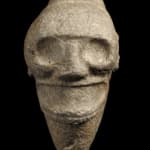Taino Stone Trigonolitos Depicting a Skull, 1000 CE - 1500 CE
Stone
10.5 x 5.5
LO.1316
Taino culture flourished in the Caribbean between c.1200-1500. The arrival of the Spanish in 1492 resulted in its rapid decline but objects such as this striking trigonolitos, also known as...
Taino culture flourished in the Caribbean between c.1200-1500. The arrival of the Spanish in 1492 resulted in its rapid decline but objects such as this striking trigonolitos, also known as a three-pointer, testify to high levels of craftsmanship. The Taino left no written language so our knowledge about them derives solely from archaeology and the testimonials of the Spanish settlers. As a result, although significant numbers of three-pointers survive, their precise function within Taino society is unclear. The central cone of these triangular objects has been interpreted in a variety of ways. Suggestions include manioc shoots (one of the main crops of the Taino), volcanoes, the roofs of Taino houses, phalluses and the human breast. None of these theories has been universally accepted and the precise origins of the shape are likely to remain a mystery. Despite this many scholars agree that these ceremonial objects were symbols of power and fertility. This seems to be supported by a letter written by Columbus in which he reports on his findings among the Taino, ‘Equally the majority of caciques (chiefs) have three stones to which they and their people have great devotion. One they say is for the fertility of the grain and vegetables that they grow; the next for mothers to give birth without pain, and the third for the water and sun when they have need.’
This striking example features a stylized anthropomorphic face that has many skull-like features. Carved from a dense, hard grey stone, the eye sockets are deep and circular. The most dramatic element is the wide grimacing mouth, which dominates the face, whether viewed from above or in profile. A thick band runs across the top of the forehead, which may represent part of a ritual headdress. The Taino people were polytheistic and also had a long tradition of ancestor worship. Three-pointer stones such as this one belong to a broader category of Taino art called zemis. This term refers to the physical incarnation of a Taino god, spirit or ancestor. Whilst the precise function of such objects may well remain a mystery- they continue to impress us with their bold abstract form and magical associations. (AM)
This striking example features a stylized anthropomorphic face that has many skull-like features. Carved from a dense, hard grey stone, the eye sockets are deep and circular. The most dramatic element is the wide grimacing mouth, which dominates the face, whether viewed from above or in profile. A thick band runs across the top of the forehead, which may represent part of a ritual headdress. The Taino people were polytheistic and also had a long tradition of ancestor worship. Three-pointer stones such as this one belong to a broader category of Taino art called zemis. This term refers to the physical incarnation of a Taino god, spirit or ancestor. Whilst the precise function of such objects may well remain a mystery- they continue to impress us with their bold abstract form and magical associations. (AM)



